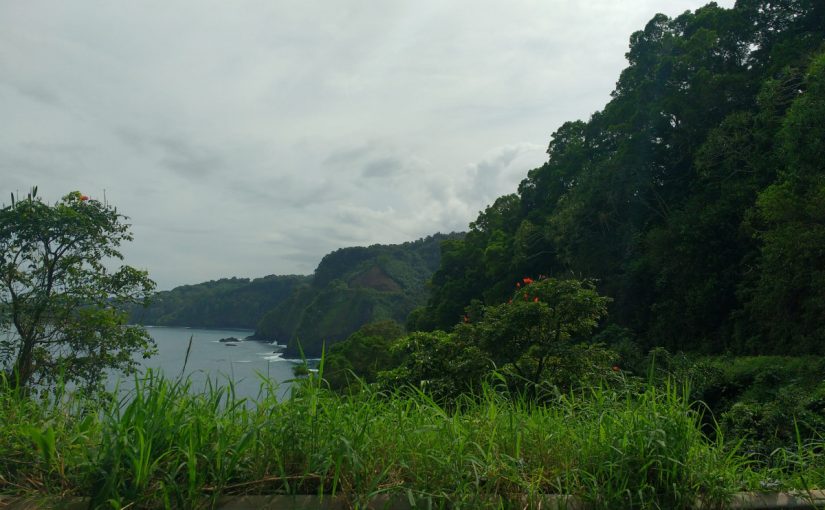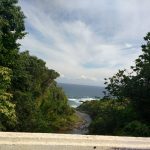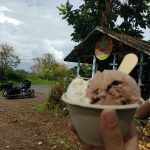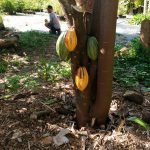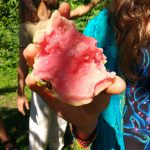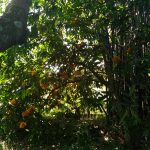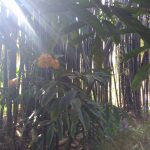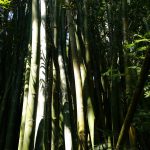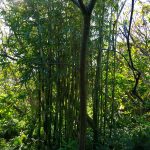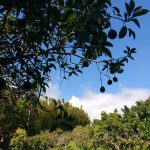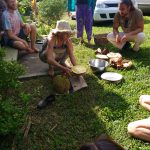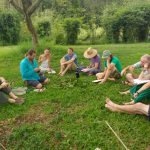I have never had so many different fruits in my life- let alone with so much variance in less than a week.
We’ve made it to Whispering Winds Bamboo in Kipahulu aka the remote jungle side of the island. On Sunday we drove an hour and a half through the most breathtaking windy roads embanked by bamboo forest, coastal shores, and waterfalls. After a while, the only marketing system comes in the form of food trucks and fruit stands. We stopped to get the world’s best coconut ice cream from a stand on the way. After we arrived we dressed up to make our way down to a neighboring farm and eco village, Lokahi, for their open mic night where they open their kitchen, “Cafe Attitude”, to the public. Each plate costs $20 donation, so I split mine with a friend and I am so glad to not have missed out on this farm’s notoriously wonderful vegan plates. We met some friends from the island who just moved there and a few people from our class performed original songs.
The next day we discussed more information for our upcoming design projects and dove into an interview with my team’s client, Spencer. We are working to design a property that he will be leasing nearby in Kipahulu. After lunch we went on a partial tour of Whispering Winds Bamboo, which has so far been the most effectively managed food forest yet. Here they harvest and process bamboo for building materials as well as a collection of fruits and flowering trees. Just on the tour I tried bright pink guava, breadfruit, zipote, and even more that was picked of trees and passed around with names I can’t remember. Aftwerwards the woman of the land here, named Virginia, opened coconuts for us to snack from and drink while she showed us how to process jackfruit, which we also ate. Then we helped her pick the edible parts from “scrambled egg fruit” which turned into a kale fried vegan “egg” dish. Virginia also brought us avocados and goods to make guacamole while she cut and fried breadfruit into french fries.
This week Jenny also taught us more graphics for mapping and showed us a slideshow for eco architecture including living roofs and innovative buildings. Speaking of architecture, Evan taught us more about different natural building styles and all the recyclable and resourceful materials that can be used to build structures. Utilizing the natural resources might include coconut palm thatched roofs or clay cob houses from mud and straw. This excites me to actually build with resources that are available and reap the rewards of ingenuity that comes from the flexibility of natural building materials. Rich from Whispering Winds spent time with us after dinner to talk about biodynamics, a practice of farming that had been held on this property for a long time. Biodynamics combines utilizing astronomy and ritualized compost preps. On Thursday we walked through the orchard with Jayanti, a permaculture nursery owner from Maui, while he taught us what to look for in a potential tree to graft. Then he demonstrated different grafting techniques which combine ways to slice the scion wood and combine with the root stalk. Unfortunately I couldn’t stay for the rest of the lesson due to feeling sick from the hot humidity that day and spent the rest of my time reading about ponds and working on the base map for our design project.
On Friday we had optional field trips to Stephen’s farm and Lokahi. Stephen’s farm could be reached by walking down to the edge of Whispering Wind’s property. There we were greeted by a kind man with his child at his hip and an outpouring field of neatly spaced fruit trees and springy ground cover from peanuts. Stephen works this land for himself and family to live off of, so we were extremely fortunate that he would give our class a tour. So far, his land has been one of the most aesthetically pleasing permaculture implementations and absolutely abundant after he started planting 20 years prior. He also utilizes natural building with bamboo and clay for amenities like an outdoor kitchen and outdoor shower/laundry room. It’s so beautiful to see the diversity of land use for different desired outputs. Out to Lokahi, the gardening overseer, Chuck, showed us about a natural Korean farming technique called Jadam. This technique of making a compost “tea” to encourage microbial growth has been widely embraced by farmers living on the Hawaiian islands. In fact, the Korean innovators behind the technique travel here to give demonstrations. The gardens seem to love the extra attention at Lokahi, since all life is bursting with pollinators and strongly rooted vegetables.
On Saturday we visited a production farm called Ono farms. They are the most successful pemaculture model on Maui for producing and selling bananas, papayas, and a handful of other plants. They started planting trees 20+ years prior and have since set the prices for those to be organically grown since they were the first in the market. It’s really inspiring to see what patience and good ethics can do to change a whole market to have access to and want more organic goods.
As we leave for Hale Akua, I am saddened that so much has passed so quickly, but I can’t help but take in all the wonderful beauty of Maui and the opportunities she still holds after the last week of the design course passes.
